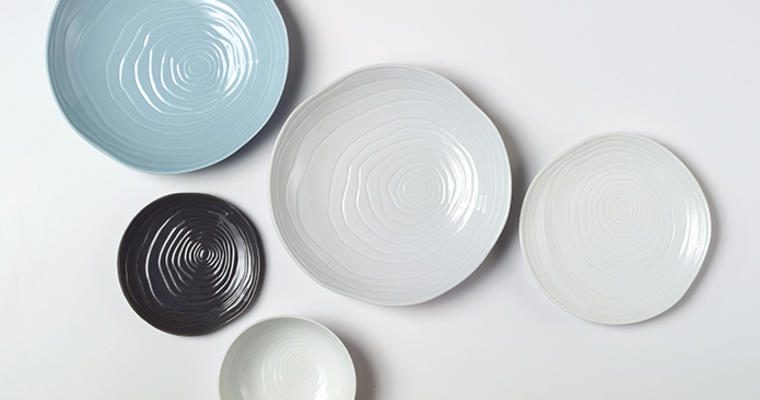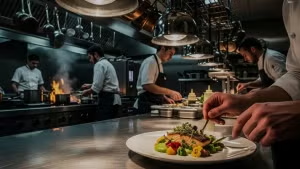Selecting tableware for a new foodservice operation, whether it’s for a restaurant, catering company or other establishment, can be intimidating. There are a lot of factors to consider at a point when, between construction and menu development, decision burnout can be high and funds may be low. To take the intimidation out of the equation and help you make an informed decision, we talked to three experts who offer guidance on placing an initial tableware order.
Begin by knowing your brand
More than a business name and a logo, a brand is a promise to the customers you most want to serve. It promises a unique experience associated with distinct benefits only you can offer. Broadly speaking, consumers use brands to make choices, and your brand differentiates your establishment from your competitors and defines who and what you are. It is your food, your customer service and everything in-between. Tableware is one of those in-between things. It reinforces your brand by offering a tactile and visual interaction.
“Tableware is an investment in your brand,” explains John Horvath, Gordon Food Service Division Merchandising Manager, Great Lakes Division. “Too often, it’s looked at as a cost, but consumers want a story and tableware can and should be a character in yours.”
Strike a balance between budget and quality
Understanding how much you have to spend on tableware should be determined early in the decision-making process. “That way, you don’t fall in love with something you can’t afford,” suggests Jean Van Horn, Gordon Food Service Tabletop and Disposables Product Specialist, and a 35-year veteran of the industry.
One important thing to keep in mind is that cost isn’t fully indicative of quality. “You can pay more for quality, design or refinement,” offers Scott Gabriel, of the Gabriel Group, which represents a selection of foodservice manufacturers in the areas of tabletop, supplies, equipment, disposables and more. Van Horn says that the manufacturer warranty is more telling. “If there’s no warranty, it’s likely not a high-quality product. If there’s a 1-year limited warranty, there’s some quality there. If it comes with a lifetime warranty, it will have a higher price, but it will likely hold up better.”
Also, consider longevity. Van Horn notes operators are getting about five years out of their tableware, but buying less and switching out select components about every 18 months. Due to the advent of social media and food photography, they have to keep up with the trends. “I tell customers, if it’s something you’re only going to use for 18 months, don’t spend a lot of money on it.”
Make your tableware budget go further
No matter your budget, one thing to get excited about is that an initial tableware order offers some advantages. “Manufacturers want to get an opening order, because that likely results in reorders, so they provide incentives that can help with the initial expense,” Van Horn says. She adds that if you pick items that are in stock, you can get away with smaller par levels, because replacements can arrive the next day or with your next delivery.
When it comes to quantities, selecting multipurpose items can help keep costs in check. For example, instead of ordering a soup bowl, salad plate and dinner plate, an oversized coupe bowl could stand in for all three. Scaling up high-volume pieces and scaling down items that won’t see as much use can also stretch the budget. Three turns is recommended for high-volume items. “That gives you one on the table, one in the kitchen and one in the dishroom,” Gabriel explains.
To get the most out of your investment, Van Horn suggests concentrating on the plateware. “That’s what gets the most attention and serves as the base for your food presentation, so it’s worth spending your dollars there.” Flatware and glassware are places you can save.
Struggling to reconcile what you want with the budget you have? Van Horn says there’s a way to make that work. “Consider options that will suffice for the short-term. Then, when you have capital flowing in six months to a year, you can re-evaluate your tableware selections.” Gabriel offers a few additional strategies: “Say you want a plate that’s $15. Use that for most of your dishes, but choose something else, like a $7 basket that you can do other things in, to bring the overall cost down. Or pick two or three key pieces from a collection you love and fill in the rest with complementary, less-expensive items.”
Align service style, dayparts and menu items with your tableware
Whether you’re creating a formal, full-service restaurant, a fast-casual enterprise or something else, service style, dayparts, menu items and table size play into tableware selection.
Service style
As Gabriel puts it, “Different service styles will often be better suited to different materials.” Here are some general guidelines to consider when narrowing the options. But keep in mind, the choices you make should ultimately reflect your brand:
- Catering, including hotels and other hospitality-based operations: Generally, more formal, full place settings with matching pieces in china or ceramic.
- Formal, full-service: Also more formal place settings with matching pieces likely in ceramic.
- Casual, full-service: Pieces should coordinate, but don’t necessarily need to match. Also, can get away with less than five pieces per place setting and ceramic is a common choice, but melamine is also moving into casual, full-service spaces.
- Limited-service and fast-casual: Metal-based serving pieces, like pie pans and 1/8th sheet pans are a common choice for this style, as well as melamine and disposables.
Dayparts
“If you’re open breakfast, lunch and dinner, you’ll want as much cross-utilization from your tableware as possible,” Van Horn advises. “The exception to that rule is if you’re a hotel or catering operation. In that case, you’ll probably want pieces specific to each daypart being serviced.”
At the opposite end of the spectrum, if you’re only open for one daypart, say breakfast, you may consider a broader variety of tableware pieces. A big plate for your egg and meat dish, a smaller plate for toast and other a la carte items, plus the serving accoutrements that go with syrup for pancakes, sugar and cream for coffee could all be considered.
Menu items
“As you’re creating your menu, be thinking about what you’re going to serve those items on,” Horvath recommends. Start by selecting tableware that supports your key menu items. If your menu is built around steaks, you might want to consider a sizzle plate. If you’re going to be serving a lot of bakeables fresh from the oven, like mac ‘n cheese or lasagna, a product that can withstand high temperatures will be important. If your concept focuses on handhelds, a tray lined in patterned parchment paper may make sense.
Table size
Table real estate is also something to keep in mind. “You want to be aware of how much room patrons are going to have at the table,” Horvath notes. For this reason, flower vases, candles and self-service caddies are being seen less and less on tables. Also, plateware, flatware and glassware should be in proportion to your tables, so knowing the sizes of all your tables (or at least your smallest tables) can be helpful.
A note on trends
The key to making tableware trends work for your operation is choosing items that are true to your brand. Overall, Gabriel and Van Horn note that things that feel familiar and comfortable are popular and look to remain that way for some time. Here’s what they say is specifically on the horizon:
- Colored plateware is coming back on the scene, edging out bright white that has been the mainstay for the last few years.
- You’ll also find earthy, homey shades and textures for plateware. Think stoneware, enamelware or pieces that look like they’re made by a potter.
- More casual linens, like bistro-striped cloth napkins or disposables that mimic burlap.
- Wood and slate serving pieces or look-alikes, such as melamine with a bark or stone pattern. (Note: wooden and slate boards are labor-intensive for the back-of-house, because they must be hand washed and sealed after each use. That is why manufacturers are responding with melamine versions.)
- Appropriate glassware for craft beers and beverages.
One thing all of our experts agree upon is to start the conversation about tableware early—12-16 weeks ahead of opening is ideal, and your order should be placed 6-8 weeks before opening. A lead like that will give you plenty of time to evaluate your options, crunch the numbers, test them out with some of your menu items, make any tweaks and still have all of your pieces on time. If you’re looking for custom components, like dinnerware with your logo, start even earlier.











